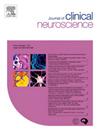Comparison of microdiscectomy and fragmentectomy on clinical outcomes for single level lumbar disc herniation: a systematic review and meta-analysis of comparative studies
IF 1.8
4区 医学
Q3 CLINICAL NEUROLOGY
引用次数: 0
Abstract
Background
Lumbar disc herniation can lead to radiculopathy, pain, and weakness. Surgery is indicated if patients remain symptomatic despite medical management, or if they develop significant neurological deficits like footdrop or cauda equina syndrome. There is no consensus on whether fragmentectomy alone or aggressive discectomy leads to improved resolution of radicular pain and leads to lower reherniation rates. To the best of our knowledge, this systematic review presents the most comprehensive and up-to-date evaluation of comparative studies comparing microdiscectomy and fragmentectomy within the last ten years.
Methods
A systematic review was conducted according to PRISMA guidelines. A search was conducted on March 19th, 2024, of PubMed, EMBASE, Scopus and Web of Science databases. The systematic review software Rayyan was used to include or exclude studies with additional filters. After full text analysis for final inclusion, demographic data as well as those regarding reherniation rates and changes in axial and radicular pain were collected. Continuous meta-analysis and meta-analysis of proportions were conducted using R versions 4.3.3. Radiographic changes were described qualitatively, as there was not enough quantitative evidence to metaanalyze.
Results
A total of 9 comparative studies with 574 microdiscectomy and 449 fragmentectomy only patients were ultimately included after screening through a total of 183 unique papers. A random effects model meta-analysis of axial pain found a standardized mean difference of 0.09 [−0.33, 0.51] (p = 0.67) with an I2 of 91%. A random effects model meta-analysis of radicular pain demonstrated an overall standardized mean difference of 0.01 [−0.14, 0.17] (p = 0.87) with an I2 of 0%. Metaanalysis of proportions for reherniation showed a relative risk of 0.96 [0.54, 1.71] (p = 0.88) with an I2 of 0%. Reoperation rates between groups showed a relative risk of 0.86 [0.47, 1.55] (p = 0.61) with an I2 of 0%. The relative risk of complication rates was 0.96 [0.35, 2.66] (p = 0.93) with an I2 of 0 %.
Conclusions
There is no statistically significant difference between VAS axial and radicular pain relief after fragmentectomy alone or aggressive microdiscectomy based on this meta-analysis. The reherniation rate was 5 % for both groups and similarly there was no difference between reoperation and complication rates. Despite advances in technique, technology, and our understanding of lumbar disc herniation, this current and comprehensive review demonstrates that both fragmentectomy and aggressive microdiscectomy are equally effective.
微椎间盘切除术和碎片切除术对单节段腰椎间盘突出症临床结果的比较:比较研究的系统回顾和荟萃分析
背景:腰椎间盘突出可导致神经根病、疼痛和虚弱。如果患者在医学治疗后仍有症状,或者出现严重的神经功能缺陷,如足下垂或马尾综合征,则需要进行手术。对于单纯椎体碎片切除术还是侵袭性椎间盘切除术是否能改善神经根性疼痛的缓解并降低再突出率尚无共识。据我们所知,这篇系统综述介绍了过去十年中最全面和最新的比较研究,比较了微椎间盘切除术和碎片切除术。方法根据PRISMA指南进行系统评价。我们于2024年3月19日对PubMed、EMBASE、Scopus和Web of Science数据库进行了检索。使用系统评价软件Rayyan纳入或排除带有附加过滤器的研究。在对最终纳入的全文分析后,收集了人口统计学数据以及再突出率和轴向和根性疼痛变化的数据。使用R 4.3.3版本进行连续元分析和比例元分析。由于没有足够的定量证据进行meta分析,影像学改变被定性描述。结果通过183篇独特论文筛选,最终纳入9项比较研究,其中574例为显微椎间盘切除术,449例为单纯碎片切除术。轴向疼痛的随机效应模型荟萃分析发现,标准化平均差异为0.09 [- 0.33,0.51](p = 0.67), I2为91%。神经根痛的随机效应模型荟萃分析显示,总体标准化平均差异为0.01 [- 0.14,0.17](p = 0.87), I2为0%。再疝比例的荟萃分析显示相对危险度为0.96 [0.54,1.71](p = 0.88), I2为0%。两组再手术率的相对危险度为0.86 [0.47,1.55](p = 0.61), I2为0%。并发症发生率的相对危险度为0.96 [0.35,2.66](p = 0.93), I2为0%。结论基于本荟萃分析,单纯椎体碎片切除术或积极微椎间盘切除术后VAS轴向疼痛和神经根疼痛缓解无统计学差异。两组再疝率均为5%,再次手术和并发症发生率无明显差异。尽管在技术、技术和我们对腰椎间盘突出症的理解方面取得了进步,但目前的综合综述表明,碎片切除术和侵袭性微椎间盘切除术同样有效。
本文章由计算机程序翻译,如有差异,请以英文原文为准。
求助全文
约1分钟内获得全文
求助全文
来源期刊

Journal of Clinical Neuroscience
医学-临床神经学
CiteScore
4.50
自引率
0.00%
发文量
402
审稿时长
40 days
期刊介绍:
This International journal, Journal of Clinical Neuroscience, publishes articles on clinical neurosurgery and neurology and the related neurosciences such as neuro-pathology, neuro-radiology, neuro-ophthalmology and neuro-physiology.
The journal has a broad International perspective, and emphasises the advances occurring in Asia, the Pacific Rim region, Europe and North America. The Journal acts as a focus for publication of major clinical and laboratory research, as well as publishing solicited manuscripts on specific subjects from experts, case reports and other information of interest to clinicians working in the clinical neurosciences.
 求助内容:
求助内容: 应助结果提醒方式:
应助结果提醒方式:


